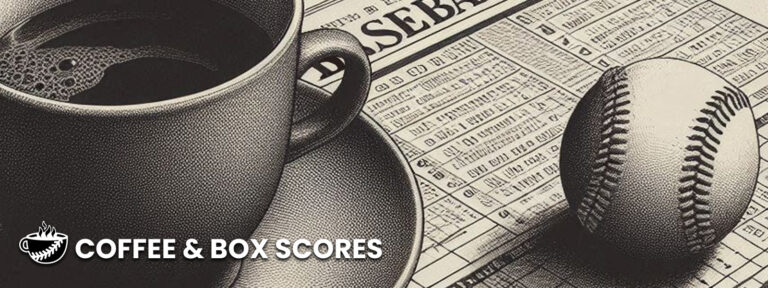In 2002, reigning NL MVP Barry Bonds opened the season looking like he had taken a couple of days – rather five months – off. Through the Giants’ first three games for that encore campaign, Bonds collected six hits with five going for extra bases. There was a double and four homers, six runs scored and nine RBI. Naturally, as this was Bonds, there were also some free passes – in this case, three. If most of these numbers feel like a reverse echo from what’s been playing out in Yankee Stadium early in 2025, they are*.
The Yankees defeated the Brewers 12-3, ending the three-game set with 36 runs scored and 15 homers. Since 1901, here are some ranks for this club against all teams through their first three contests:
~The 36 runs come in as the third most, behind the 41 from the Cubs in 1954 and the 40 by the Brewers in 1978.
~The 15 home runs are tied for the most, matching the 2006 Tigers.
~Their 82 total bases are fourth most, after the 2006 Tigers had 91, the 2019 Dodgers tallied 86 and the 1954 Cubs had 84.
~Their 18 extra-base hits tie for the ninth most. Of the four specific categories explored here, this is the one where there is a higher-ranked Yankees club. In 2003, the team compiled 21 extra-base hits, which is tied for the second most, behind the ’54 Cubs and that team’s 22.
In the Yankees’ win, Aaron Judge connected on his fourth homer of the year before drawing three walks. He ended the day 1-for-1 with four runs scored.
~This game marked the fifth time in his career Judge had posted a line featuring at least four runs scored and at least four times reaching safely. There are six players in Yankees history who’ve had more such box scores. Lou Gehrig had 18, while Babe Ruth had 11 and Earle Combs reached 10. Charlie Keller and Álex Rodríguez come in with seven. Joe DiMaggio had six while Red Rolfe and Derek Jeter also had five. Two of Judge’s five have come in his past two games; he’s the only Yankee to have assembled back-to-back performances like this. There are nine others since 1901 to have had consecutive games with four-plus runs and four-or-more times on base: Fred Snodgrass (1912), Pete Fox (1935), Hal Trosky (1936), Mel Almada (1937), César Cedeño (1977), Paul Molitor (1983), Mark McGwire (1987), David Wright (2005) and Hunter Pence (2016).
~Through three games, Judge has reached base safely nine times, tallied 20 total bases, scored eight runs and driven in 11. All these numbers are tops in the Majors, except for times on base, where he is tied for seventh. Since 1901, for all players through their teams’ first three games:
*His 20 total bases are third most, behind Adrián González’s 27 in 2015 and Chris Shelton’s 22 in 2006.
*His 11 RBI are tied for the second most, behind Dolph Camilli’s 12 from 1935. Chris Davis also had 11, in 2013.
*His six extra-base hits (four homers and two doubles) are tied for the second most, behind González’s seven (five homers and two doubles) in 2015.
*Barry Bonds in 2002 v. Aaron Judge in 2025 – Through 3 Team Games
| Player | H-AB | R | HR | RBI | XBH | Times on Base | Total Bases |
| Bonds | 6-for-8 | 6 | 4 | 9 | 5 | 10 | 19 |
| Judge | 6-for-11 | 8 | 4 | 11 | 6 | 9 | 20 |
Nick Pivetta (7 IP, 1 H) and two relievers combined on a one-hit shutout while facing the minimum 27 batters and San Diego rolled to a 5-0 win over Atlanta. The right-hander’s line has been something of a specialty – of his and the Padres’ – this decade. Since the start of the 2020s, Pivetta has finished four outings with at least 7.0 innings, no runs and just one hit allowed (in all four, he went exactly seven frames). Those four tie him with Joe Musgrove* for the third most in the Majors, behind Dylan Cease’s* seven and Blake Snell’s five. Of these four hurlers’ combined 20 outings, 12 were/are as members of the Padres. In all, San Diego has gotten 14 such starts since 2020, the most in the Majors (Sean Manaea and Michael Wacha contributed the other two).
*Musgrove and Cease each have a no-hitter in their respective contributions
San Diego’s shutout win moved the club to 4-0 to start the year. It’s only the second time the franchise has opened with four victories in a row, after the pennant winners from 1984. Conversely, this outcome gave this Braves club its first 0-4 start since their pennant (and World Series) winning team from 2021.
Tyler Soderstrom connected on his third home run of the year in the Athletics’ 2-1 loss to the Mariners. He’s the 12th player in franchise history to have that many through four games, joining a list that features Al Simmons (1930), Jimmie Foxx (1932), Bob Johnson (1937), Gus Zernial (1954), Reggie Jackson (1974), Mark McGwire (1989), Terry Steinbach (1994), Scott Brosius (1996), Gerónimo Berroa (1997), Yoenis Céspedes (2012) and Khris Davis (2019).
In the Athletics’ loss, starter JP Sears allowed two runs over 6.2 innings. The club’s four starters – Sears, Luis Severino, Jeffrey Springs and Osvaldo Bido – have combined for a 1.14 ERA, third lowest in the Majors. The quartet has also produced three quality starts, tied for the most in the big leagues and collectively, has the second-best Game Score average in the Majors.
In Texas, Jacob deGrom allowed two hits and two walks in five scoreless frames as his Rangers slipped by the Red Sox, 3-2. The righty owns a 2.51 career ERA, the second lowest among all pitchers in the liveball era with at least 200 starts; the number is really helped by his overall work when pitching in his home ballpark.
1920-2025: Lowest Home ERA (min. 100 GS at Home)
2.14 Jacob deGrom
2.22 Clayton Kershaw
2.48 Sandy Koufax
2.53 Don Drysdale
2.58 Whitey Ford
2.58 Andy Messersmith
2.58 J.R. Richard
As mentioned, deGrom owns the second lowest overall ERA since 1920 among those with at least 200 career starts. Kershaw owns the lowest, while Ford and Koufax come in with the third and fourth lowest, respectively. Messersmith is tied for the fifth lowest and Drysdale owns the 13th lowest. Richard is tied for the 31st lowest, (coincidentally, or not really) matched with another Astro, Don Wilson.
In Boston’s loss, Wilyer Abreu doubled and drew three walks. In four games, the 25-year-old has reached safely a league-leading 12 times and has amassed 15 total bases. In the modern era, he’s one of 42 players to get to those two numbers through his team’s first four games. In the club, he joins three other Red Sox players: Ira Flagstead in 1926, Joe Cronin in 1941 and Adam Duvall just two seasons ago.
Cardinals third baseman Nolan Arenado doubled in the team’s 9-2 win, his third straight game with an extra-base hit. Through his first 10 seasons (the stretch ends in 2022, when he finished third in MVP voting), Arenado produced extra-base hits in 11.5% of his plate appearances. At the end of that year, Arenado was one of four players in the 21st century to have a percentage of at least 11.5 in a minimum of 4,000 trips to bat – his three partners were Barry Bonds, David Ortiz and Manny Ramírez. In 2023-2024 combined, his 7.5 XBH% stood in a tie for 89th among the 115 players with at least 1,000 combined plate appearances.
Before Arenado in 2025, the last Cardinal to post at least one extra-base hit in each of the team’s first three games was Arenado in 2022. Before then, Reggie Sanders in 2005 had been the last to do this.
In Cleveland’s win over Kansas City, leadoff hitter Steven Kwan was 3-for-5 while Kyle Manzardo – batting third – had a pair of hits (including his second homer of the year). Both players have reached safely multiple times in each of the club’s first three games. The last season to see teammates do this for the franchise came more than a decade ago, when Michael Bourn, Carlos Santana and Michael Brantley all made this claim for the 2013 team.
White Sox right-hander Davis Martin went six innings and allowed two unearned runs in the team’s loss to the Angels. The effort continued the stinginess being authored by the team’s starters, after Sean Burke threw six scoreless innings on Opening Day and Jonathan Cannon followed with five innings and no runs. In the liveball era, the White Sox had never before opened the season with three straight games in which their starters allowed no earned runs.
Derek Hill scored the game-winning run on a wild pitch in the ninth to give the Marlins a 3-2 victory over the Pirates. Miami won three of four in this set, with all three victories being of the walk-off variety. They are the third team in the Division Era to have three such success stories so early. In 1985 and 1998, the Mets had three walk-off wins through their first four games.
Andrew McCutchen hit – with a big fly – a big milestone on Sunday, reaching 800 career extra-base hits. He’s the 125th player to reach the bar, and one of 18 to have gotten there in a career which also saw the player man center field for at least 1,000 games (although he hasn’t played a full season in center since 2017). Curiously, he’s the first of the 18 to have debuted in the 21st century (his first game came in 2009). The previous five to do this, by most recent debut season: Carlos Beltrán in 1998, Torii Hunter in 1997, Andruw Jones in 1996, Johnny Damon in 1995 and Jim Edmonds in 1993.
Tomoyuki Sugano made his Major League debut on Sunday, allowing two runs over four innings. The 35-year-old is the fifth Japanese-born pitcher to make a start this season, following Shota Imanaga, Yusei Kikuchi, Roki Sasaki, and Yoshinobu Yamamoto. There have been six different seasons in which this particular number apexed at six (1999, 2002, 2009, 2014, 2023 and 2024), and no season has exceeded six.
Thanks to Baseball Reference and its extraordinary research database, Stathead, for help in assembling this piece.

Roger Schlueter
As Sr. Editorial Director for Major League Baseball Productions from 2004-2015, Roger served as a hub for hundreds of hours of films, series, documentaries and features: as researcher, fact-checker, script doctor, and developer of ideas. The years at MLB Production gave him the ideal platform to pursue what galvanized him the most – the idea that so much of what takes place on the field during the MLB regular and postseason (and is forever beautifully condensed into a box score) has connections to what has come before. Unearthing and celebrating these webs allows baseball to thrive, for the present can come alive and also reignite the past.


